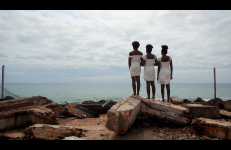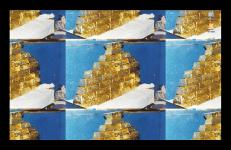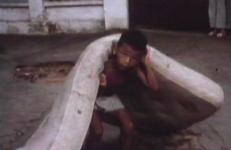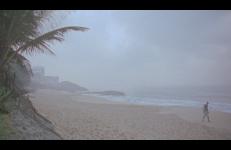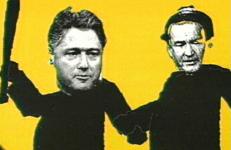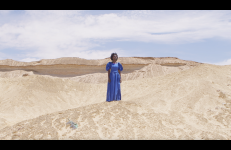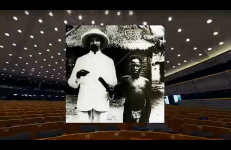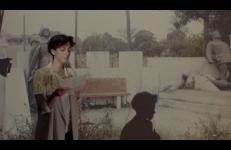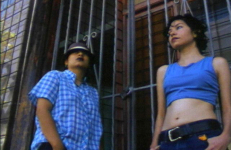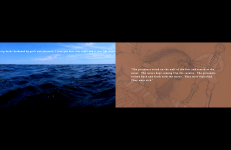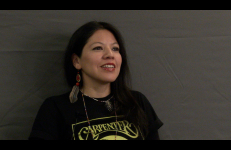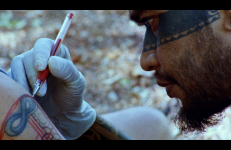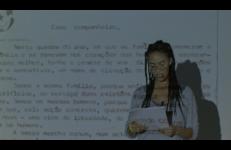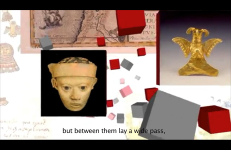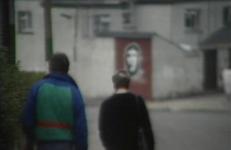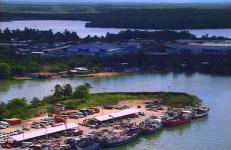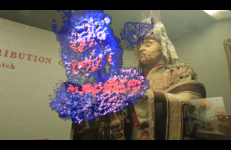"Interested in the hidden corners of exoticism and a reinterpretation of history as an aesthetic challenge, Colombian resident in France, Laura Huertas Millán (Bogotá, 1983), presents in Aequador—in her own words—'a parallel present modified by virtual reality, an oneiric allegory, an uchronic dystopia.' With foundations on science fiction—uchronia as a source for an alternative history can actually be seen as a subgenre—, Aequador establishes parallelisms—in a complex and deliberately fragmented way—between the (virtual) relics and ruins of an ideal 3-D architecture embed
Post-colonialism
In 1972 Eric Siegel, an early pioneer of video art, set out on an extreme adventure driving from Europe six thousand miles overland to India. He was one of the first people to use the revolutionary new technology from Sony Corporation, the Portapak. This was the first small portable video camera/recorder combo that was the predecessor of today’s camcorders. Together with his friend Anthony they documented the trip. This video is the portion of the trip that took them through Afghanistan, one of the most exotic places along the way.
These are the western lands of the mind. The western tracks in the land. The western landscapes of our time. The wasted times of our lives. So is the rest of the Capitalocene civilization.
The introductory title to The Blindness Series, aletheia presents an indexing of categories investigating different aspects of blindness as metaphor. Stylistic preference for the techniques and conventions of MTV, and American Television in general, provides the means to create connections among the categories of cosmetic surgery, sexuality, technology, language, hysterical blindness, and actual blindness.
This title is also available on Tran, T. Kim Trang: The Blindness Series.
A welcome as warning. Frequent collaborators and proxies for New Red Order - Jim Fletcher and Kate Valk co-host a confrontation with the viewer about the passivity of ongoing settler-colonial occupations, and introduce a contrite, yet self-congratulatory stew of televised recordings of public apologies to Indigenous peoples from the heads of state around the globe. Featuring Donald Trump, Queen Elizabeth, Prime Minister of Australia Kevin Rudd, President of Taiwan Tsai Ing-wen, Prime Minister of Canada Justin Trudeau and more!
All that burns melts into air as “All that is solid melts into air” by Marx and Engels brings us to an imaginary of the present time marked by the reality and urgency of global warming.
“All that is solid melts into air, all that is holy is profaned, and man is at last compelled to face with sober senses his real conditions of life, and his relations with his kind.”
— Karl Marx and Friedrich Engels, The Communist Manifesto, 1848
amaurosis is an experimental documentary about Dat Nguyen, a blind guitarist living in Little Saigon, Orange County, California. Dat Nguyen was a "triple outcast": blind, Amerasian, and an impoverished orphan. His American father left Viet Nam in 1973, and his mother died in 1975. Living on the streets of Saigon, he sold lottery tickets for food money. At the age of 12, Dat met a classical music teacher who was also blind and who taught him to read Braille as well as supported him.
The Diaspora Suite
Oscillating between a street festival in Philadelphia, the slave forts and capitol city of Ghana, and the New Jersey shore, American Hunger explores the relationship between personal experience and collective histories. American fantasies confront African realities. African realities confront America fantasies.
A significant amount of the hand-drawn animation seen on television today is cartooned in sweatshop-like animation factories in Korea, China, and the Philippines. The writers and animators who form Animaquiladora sharpened their skills in one such factory located in Tijuana, Mexico. After years of animating logos for the American talk show Regis and Kathie Lee, Lalo Lopez and Alex Rivera escaped from the hellish sweatshop of Tijuana to seek better lives in Los Angeles and New York.
As If the World Had No West tells of the journey of a young woman who travels through the desert and who, through her relationship with the Mirabilis, ancient plants, listens to the cosmos. She listens to her elders, the earth, fire and air. The drought calls the rain, the ashes show the way, the plants tell her the stories of colonization, of the beginning of the world when the desert was still scrubland and there were trees and flowers.
The city of Kinshasa and its liberation architectural spaces are here embodied through a journey of a woman that walks alone through the ghosted spaces of history. The spaces represented in the film build on heritage built before and after the wars of independence to signal the appropriation and resignification of power dogmas and canons of beauty and Hellenistic aesthetics through the presence and the protagonist of the black woman.
Cacheu is a 10-minute shot of a lecture, performed by Joana Barrios, revolving around four colonial statues, which are stored today at the Fortress of Cacheu, one of the first bastions constructed by the Portuguese in 1588 in order to facilitate slave trade in the West African country of Guinea Bissau. Barrios evokes symbolic conflicts by tracing back different contexts in which the statues make an appearance: on a pedestal during Portuguese colonialism, dethroned and broken in pieces after Independence in the film Sans Soleil by Chris Marker, as background ghosts in Mortu Nega by Flora Gomes, and finally displayed at the Cacheu fort. The montage is a process that takes place before shooting, so that the image production is a result of a performative assemblage between text, acting, projected image and the framing of the camera by the director of photography, Matthias Biber.
Veronica Majano depicts the character of a street in the Mission District of San Francisco. This street is personified as a fifteen year old Salvadoran/Ohlone girl on a search to understand the changes brought on by colonization, dislocation, and more recently, gentrification. Tracing the history of the Mission from its first residents, the Ohlone Indians, Chula explores the effects of re-colonization on memory and memory loss. For Chula, memory loss is a birthmark that was passed down to her from her ancestors.
Cloudless Blue Egress of Summer is a two-channel synchronized video installation. A composite of the two channels presented side by side in one video is available from Video Data Bank for educational use only.
Colectivo Los Ingrávidos (Tehuacán) is a Mexican film collective founded in 2012 to dismantle the commercial and corporate audiovisual grammar and its embedded ideology. The collective is inspired by the historical avant-gardes, and their commitment to using both form and content against alienating realities. Their methods combine digital and analog mediums, interventions on archival materials, mythology, agitprop, social protests, and documentary poetry.
A synaesthetic S16mm portrait made between French Polynesia and the French province of Bretagne, Color-Blind recruits the restless ghost of Paul Gauguin as an uneasy spirit guide in excavating the colonial legacy of a decidedly syncretic post-colonial present.
Staged at the Haus der Kulturen der Welt, Berlin, Conakry is a sequence shot on 16mm film that travels through time, space and media to revisit one film reel from the Guinean archive. This particular reel documents an exhibition curated by Amílcar Cabral at the Palais du Peuple in 1972 in Conakry, Guinea, reporting on the state of the war against Portuguese rule. César invited the Portuguese writer Grada Kilomba and the American radio activist Diana McCarty to reflect on these images and their history.
Here, a double morphology of conversion forces us to think about the trance of non-reconciliation, outburst and trance that go through the centuries of colonial violence until reaching us in the tension of an audiovisual disjunction: visible and enunciable. On the one hand the museum, habitat of barbarism, on the other hand the voice, place and body of the furious testimonial. Religious conversion that conveys communal violence. Archaeological conversion that imposes object immobility.
This video takes its departure from the BBC's coverage of the killing of three IRA volunteers by British Security Forces in Strabane, a small town on the border between Northern Ireland and the Irish Republic. Interrogating television discourse, the video examines what is referred to as the British “shoot to kill” policy of planned assassination in the North.
This video takes its departure from the BBC's coverage of the killing of three IRA volunteers by British Security Forces in Strabane, a small town on the border between Northern Ireland and the Irish Republic. Interrogating television discourse, the video examines what is referred to as the British “shoot to kill” policy of planned assassination in the North.
Uncomfortable journeys through the work and ideas of Christopher Cozier, a leading contemporary artist in the Caribbean. The video presents Cozier's witty and incisive drawings, installations and videos in the context of post-independence Trinidad with its oil-rich economy, complicated ethnic politics, and vibrant cultural forms.
Crosswinds is part of the fieldtrip series. By definition a crosswind is any wind that has a perpendicular component to the line or direction of travel. The title, Crosswinds, acts as a symbol of crossed pollination of cultures and identities. Crosswinds is a work that conceals many worlds, the world of the past and of the present – a world of memories of a colonial past which is a ruin that constructs the identity of a postcolonial present. It is a crossed geography that plays with the dichotomy of being in between different locations.
The looped work Culture Capture 001 takes place within the American Museum of Natural History. We come to recognize the masked figures observing Native American objects held inside the collection cases as accomplices of the public secret society. They diligently photograph, scan, and record these objects through smartphones, transferring the images and dimensional information of them into data to potentially be reconstituted and liberated from these settings.




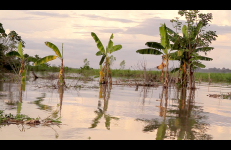
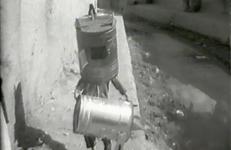
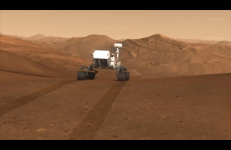
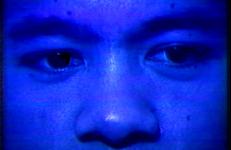
![AlienNATION [star spangled], New Red Order AlienNATION [star spangled], New Red Order](/sites/default/files/styles/215x140/public/2025-02/ALIENNATIOSS.jpg?itok=fa7jU7tV)
